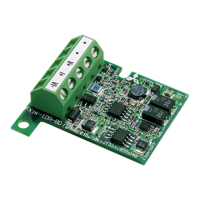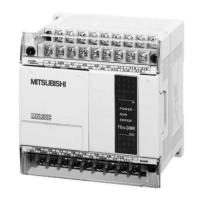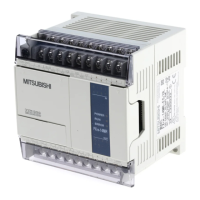FX Series Programmable Controlers Applied Instructions 5
5-96
d) When the ‘zero point’ input (D+2) is received the contents of device S+0 is reset to ‘0’
(zero). Before starting any new operation it is advisable to ensure the rotary table is
initialized by moving the ‘zero point’ drive dog or marker around to the ‘zero point’ sensor.
This could be considered as a calibration technique. The re-calibration of the rotary table
should be carried out periodically to ensure a consistent/accurate operation.
e) Devices D+3 to D+7 are automatically set by the ROTC instruction during its operation.
These are used as flags to indicate the operation which should be carried out next.
f) All positions are entered in the form of the required encoder pulses. This can be seen in the
following example:
- Example:
A rotary table has an encoder which outputs 400 (m1) pulses per revolution. There are 8
stations (0 to 7) on the rotary table. This means that when the rotary table moves from one
station to its immediately following station, 50 encoder pulses are counted. The ‘zero
position’ is station ‘0’ (zero). To move the item located at station 7 to station 3 the following
values must be written to the ROTC
instruction:
S+1=3 × 50 = 150 (station 3’s position in encoder pulses from the zero point)
S+2=7 × 50 = 350 (station 7’s position in encoder pulses from the zero point)
m1= 400 (total number of encoder pulses per rev)
The rotary table is required approach the destination station at a slow speed starting from
1.5 stations before the destination. Therefore;
m2= 1.5 × 50 = 75 slow speed distance either side of the destination station (in
encoder
pulses)

